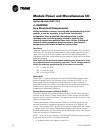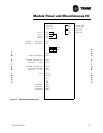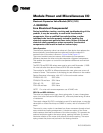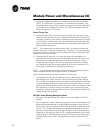
RLC-SVD03A-EN 55
Module Power and Miscellaneous I/O
ICS Communications
ICS (Tracer) communication is handled the same as on previous products
using the Trane proprietary Comm3 standard 1200 baud isolated serial
communication link. The following are some things to check when experi-
encing loss of ICS communications:
1. If ICS control is desired, check that “Tracer” has been selected in Set-
point Source of the Operator Settings Menu. In any case, the Tracer
should be able to communicate to the chiller for monitoring purposes,
regardless of the Setpoint Source selection. Refer to Figure 11 for a
description of the normal operation of setpoint and setpoint reset arbitra-
tion.
2. Check for the proper ICS address in the Service Settings Menu and com-
pare to the address programmed at the ICS device.
3. Check for proper termination of the twisted pair communication link wir-
ing to terminals TB2-1 and TB2-2 (or TB2-3 and TB2-4)
4. Check for a diagnostic at the display indicating loss of IPC communica-
tions with the Options module. This could indicate IPC bus problems or a
dead Options module. (See Options Module (CSR) (1U2) on page 50). The
Options module needs to receive 4 good packets of data from the CPM
before it will talk on the ICS link.
5. Check power to the Options module and the condition of the fuse. (See
Power Supply on page 41)
6. Check the Test Point voltages on the module. (See Test Points on page
47).
NOTE: The red LED on the module blinks each time a proper message or
query is received from the Remote ICS device.
I/O Terminals
For the checkout of the I/O refer to the block diagram of the module on the
following page and the Chiller Wiring Diagrams for low and high voltage
circuits. All voltages are measured differentially between terminal pairs
specified unless otherwise indicated. The first terminal in the pair is the
positive (or hot) terminal. Voltages given are nominals and may vary by ±5%.
Unregulated Voltages (unreg) may vary by ±25% and 115 VAC voltages may
vary by ±15%.


















